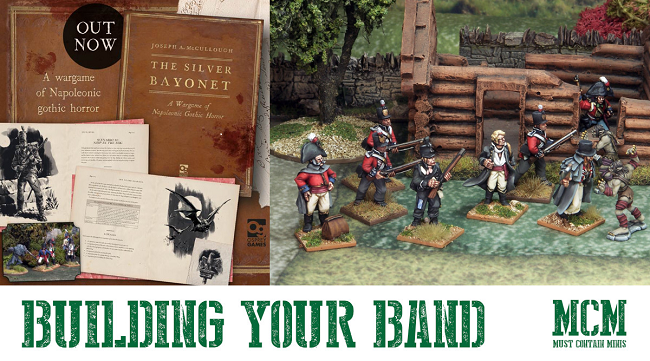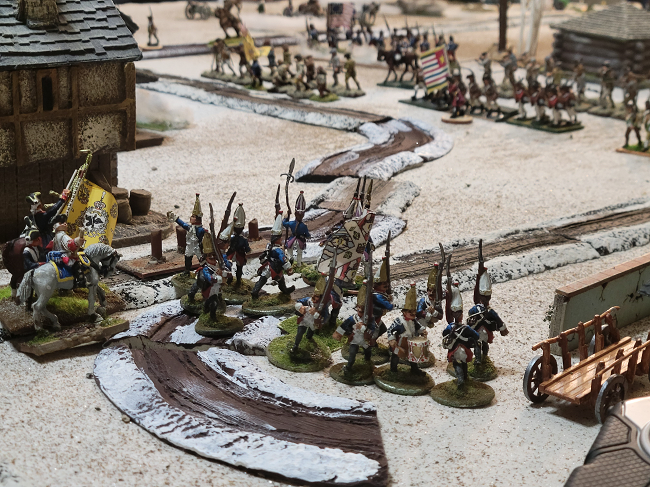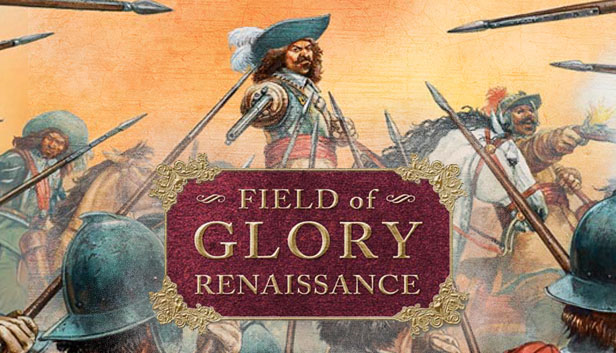Republished with the permission of Publisher and Owner of MWAN Mr. Don Perrin
This terrific article by Steven Lawrence appeared in issue 117
Dress Uniform Colors of European Volunteer Regiments
All coats were red. Headgear consisted of the standard Kilmarnock style cap. All belts were to be white. Other details are presented in the following table:
| Battalion | Facings | Lace | Trousers | Havelock |
| 1st Bengal | Sky blue | Gold | White | White |
| 1st Bengal Light | Dark Blue | Gold | White | White |
| 1st Bengal Fusiliers | Dark Blue | Gold | Navy Blue | Blue |
| 2nd Bengal Fusiliers | White | Gold | White | White |
| 3rd Bengal Light | White | Gold | White | White |
| 1st Madras | White | Gold | Black | White |
| 1st Madras Fusiliers | Dark Blue | Gold | Black | White |
| 2nd Madras Light | Pale Buff | Gold | Black | White |
| 3rd Madras | Pale Yellow | Gold | Black | White |
| 1st Bombay | Dark Blue | Gold | White | Buff |
| 1st Bombay Fusilier | Dark Blue | Gold | White | Buff |
| 2nd Bombay Light | Pale Buff | Gold | White | Buff |
| 3rd Bombay | Pale Yellow | Gold | White | Buff |
Loyal Native Regiments in the Service of Great Britain
The native regiments of Bombay and Madras Presidencies remained loyal to the company, but few men were sent to put down the mutiny. On the other hand, large numbers of Sikh, Punjab, Jat, Rajput, and Pathan units were raised and sent to quell the unrest in Bengal and Dudh Provinces. The major reason for this was a longstanding hatred of these races for Bengalis. These races would have little or no objection to the grease of the Enfield rifle cartridges. These warrior people proved invaluable in the Great Mutiny, and many horse and infantry units were raised to assist those units already in service along the Afghanistan frontier.
The standard dress of these units was kharkee. Clothing normally consisted of a colored turban (anything from white to red to blue to kharkee), a loose-fitting pullover tunic with open neck (called an alkaluk), a loose-fitting knee-length pair of puttees (cloth wrappings), and slippers (chapplis) for footwear. All belts and equipment were brown or black. The regiments carried the older pattern muzzleloaders, but some Sikh units carried the new Enfield rifles.
Three of the Sikh regiments’ uniforms had considerable variation from the normal style. Hodson’s Horse (Corps of Guides) wore kharkee, but also wore a red turban, cuffs, trim, and sash. This unit carried the Enfield carbine. The 1st Sikh Regiment (Coke’s Rifles) wore a dark blue uniform with black cuffs and trim. The turban was an absolute riot of colors. The 2nd Sikh Regiment wore a red coat, ankle-length white trousers, and red turban. Both of these regiments used the Enfield rifle.
The 1st and 4th Bengal Irregular Light Cavalry Regiments (Skinner’s Horse) wore bright yellow alkaluks, bright red trousers with yellow trim, and red sashes. Skinner’s Horse wore a skullcap-type helmet with a small silver cross atop a wire in the front (about 6 inches in height). The 1st Regiment’s helmet had a trim of black fur. The 3rd Regiment’s helmet had a blue and gold puggril. These regiments were lance and carbine armed.
The Bombay Regiments wore a standard native regiment uniform of red coatee with tails and white turnbacks, yellow collar and cuffs with gold cuff flap. Trousers were blue (or white in summer) with a one-and-a-half-inch wide yellow stripe on the outer seam. Belts were white with a black cartridge box. The blue water bottle and a brass Iota (drinking bowl) completed the attire. Headgear was either a tall peakless shako or, more commonly, the black kilmarnock cap with a two-inch blue stripe around the base. All men were armed with the muzzleloader.
The Madras native regiments wore the same native regiment uniform coat as the Bombay troops. Trousers were knee-length, black, and baggy. No coverings were worn normally on the lower legs. The headgear was a strange shako thing that resembled a chef’s hat with a brass or black fish-mouth ball on top. This was made of cloth or hide stretched over a wicker frame. Few units from this presidency were sent to aid in the quelling of the mutiny.
The Native Light Cavalry Regiments wore a tight-fitting uniform of French Blue (a pale blue-gray) trimmed in black. High black boots and a dark blue over black Kilmarnock completed the Bombay regiments. The Madras regiments wore short black boots and a shako like the infantry with a diagonal stripe of white-trimmed light blue from high right to low left.
The Native Irregular Light Horse Regiments wore the native costume of alkaluk, pyjamas, kummerbund, (a wide tight sash), and a turban. These units were lance armed and carried carbines and scimitars. Excellent horsemen, all were Sillidar horse.
The Native Artillerymen wore white or kharkee undress uniforms. Headgear was either a turban of the same color or the regular cap covered in a Havelock and usually worn with puggri. White officers and gun captains normally wore a dress blue coat and white trousers of the Bengal Artillery Regiments. All equipment was painted gray, and quickly faded.
Uniforms of the Bengal Light Irregular Horse Regiments
| Clothing Item | 1st (Skinner’s) | 2nd (Gardner’s) | 3ra (Rohilla) |
| Status | Loyal | Loyal | Mutinied |
| Alkaluk (coat) | Yellow | Kelly Green | Red |
| Coat Trim | Gold | Silver | Blue |
| Pyjamas (pants) | Red | Red | Yellow |
| Kummerbund | Red and Gold | Red | Red and Gold |
| Belts and trim | Black and Silver | Black | Black |
| Headgear | Helmet | Red Turban | Black Fez & Blue puggri |
| Clothing Item | 4th (Skinner’s) | 5th (Cough’s) | 6th (Oudh) |
| Status | Loyal | Mutinied | Loyal |
| Alkaluk (coat) | Yellow | Red | Red |
| Coat Trim | Dark Blue & Silver | Dark Blue | Blue & Gold |
| Pyjamas (pants) | Red | White | Yellow |
| Kummerbund | Black | Crimson | None |
| Belts and trim | Black & Gold | Black | Blue |
| Headgear | Helmet Blue & Gold puggri | White Turban | Yellow Turban, off black Helmet |
| Clothing Item | 7th (2nd Dudh) | 8th (3rdOudh) | 9th (Christie’s) |
| Status | Loyal | Loyal | Mutinied |
| Alkaluk (coat) | Red | Red | Red |
| Coat Trim | Blue & Gold | Blue & Gold | Yellow |
| Pyjamas (pants) | Yellow | White | Yellow |
| Kummerbund | Blue | None | Blue |
| Belts and trim | Black | Scarlet & Gold | Black |
| Headgear | Red Fez Blue Puggri | Red Turban | Yellow Turban w puggri Blue Stripes |
| Clothing Item | 10th (Bunde) | 11th (4th Oudh | 12th (5th Oudh) |
| Status | Disarmed | Mutinied | Mutinied |
| Alkaluk (coat) | Blue | Scarlet | Dark Blue |
| Coat Trim | Red & Gold | Gold | Yellow |
| Pyjamas (pants) | Red | Yellow | Yellow |
| Kummerbund | Red | Red | Crimson |
| Belts and trim | Black | Black | Black |
| Headgear | White Turban off Black Busby | Yellow Turban | Crimson Turban |
| Clothing Item | 13th (6th Oudh) | 14th (7th Oudh) | 15th (8th Oudh) |
| Status | Mutinied | Mutinied | Mutinied |
| Alkaluk (coat) | Blue | Blue | Red |
| Coat trim | Gold | Silver | Black & Gold |
| Pyjamas (pants) | Red | Red | Blue |
| Kummerbund | None | None | Dark Blue |
| Belts and trim | Black | Black | Black& Gold |
| Headgear | Red | Red Turban | Dark Blue Turban |
| Clothing Item | 16th ( 9th Oudh) | 17th (10th Oudh) | 18th (11th Oudh) |
| Status | Mutinied | Loyal | Loyal |
| Alkaluk (coat) | Red | Scarlet | Blue |
| Coat trim | Gold | Gold | Scarlet & Lace |
| Pyjamas (pants) | Yellow | Yellow | Red |
| Kummerbund | None | None | Red |
| Belts and trim | Black | Black | Brown |
| Headgear | Yellow Turban | Yellow Turban | Red Turban |
Punjab Frontier Irreqular Light Horse Reqiments Raised in 1857
| Clothing Item | 1st Hodson’s | 2M Hodson’s | Robartes | 1st Sikh |
| Alkaluk (coat) | Kharkee | Dark Blue | Kharkee | Kharkee |
| Coat trim | Brick Red | Red | None | None |
| Pyjamas (pants) | Kharkee | White | Kharkee | Red |
| Kummerbund | Brick Red | Red | Red | Red |
| Belts and trim | Black | Brown | Brown | Black |
| Headgear | Brick Red Turban | Red Turban | Red Turban | Kharkee Turban |
| Clothing Item | 4tn Sikh | Jat | Fane’s |
| Alkaluk (coat) | Dark Blue | Blue | Kharkee |
| Coat trim | None | None | None |
| Pyjamas (pants) | White | White | Kharkee |
| Kummerbund | Red | Red | Red |
| Belts and trim | Black | Black | Black |
| Headgear | Red Turban | Red Turban | Red Turban |
These regiments all remained loyal to the Crown and Company.
Making an End. A Compendium of Items Both Lost and Found, and a Few Notes on the Leading Players in this Great Drama of Life and Death in Bengal and Oudh
During the Great Mutiny, the instance of a complete regiment of the Queen’s Army (the common name applied to British Units) being at the same battle was rare. The “Armies” that were fielded by John Company were normally composed of whatever was to hand or could be raised and consolidated in a hurry. The entire cavalry force defending Lucknow was made up of the Officers of Bengal regiments that had mutinied and local British civilians who owned or could acquire a mount. There was a similar force with the besieging forces at Delhi. The 60th Rifles (KRRC) fielded the most complete force in the Del hi Field Force with 6 – later 7 – of its companies present. The 75th foot, the Sirmoor Battalion (the 2nd Goorkha Regiment), and the 6th Dragoon Guards fielded nearly complete units. Only those forces that arrived later, such as the Sikh and Punjab Field Force regiments, would be fielding a nearly full compliment. Even the 91st Highlanders had two companies retained in Calcutta to protect the British civilians there.
Any wargamer presenting a game for his fellows would be entirely justified in presenting a wide selection of troops and types. When one is selecting forces for the Pandies, the units could, and probably should, be of varying sizes, as there was no standard unit organization above platoon and company level. Often the Pandies simply followed the leader of their choice. Local militia forces and the retinues of local chieftains would be more regularly organized, but would be of lesser morale.
British leaders tended to be intelligent and rather intrepid if in independent command, but often in conflict if in a command with other officers of similar rank, especially if one happened to be a Queen’s officer and the other a John Company officer. A Queen’s officer would technically outrank the John Company officer, but often they would end up in a feud or separate into two independent commands. The original delay that allowed the mutineer regiments at Meerut to march to Delhi was a conflict over whether the Queen’s officer present on the parade ground was in command or if the ranking general (a rather useless overly rotund fellow, not unlike the US General Taft) who was not anywhere to be found was in command because the orders stated that “the ranking officer present should take the command and move immediately to halt the regiments which had mutinied.” The Queen’s officer present decided that since the senior general was “present,” even though he could not be found, he was in charge. It would be three hours before the ranking general showed up, and he would not budge for three days! So much for moving immediately to halt the mutiny.
The difficulties between General Havelock and Sir James Outram, his senior commander, were also a cause for great distress. General Havelock was the commander of the relief force sent to relieve Lucknow. Sir James had been appointed to command the forces in Bengal and Oudh, but didn’t reach the field army for several weeks, during which time Havelock won several impressive victories. Sir James assured General Havelock the he, sir James, would in no way interfere with the direct handling of the field army. He, Sir James, would only conduct the overall strategy of the reconquest of the provinces. He promptly set about overruling and countermanding everything General Havelock did. This lead to a direct conflict between the two, all done with perfect civility, which left Sir James irritated with General Havelock and General Havelock disheartened and all but broken. Major Harry Havelock (General Havelock’s son serving under General Havelock in the field) was livid and lost no opportunity to vilify Sir James Outram regardless of the time, place, or persons present. Needless to say, this led to indecision and lack of purpose and resolve in the army.
Similar situations arose in the Delhi Field Force, most prominently between each and every one of the senior commanders and General Niell, who was perhaps the epitome of the Victorian “Christian” General. This man was all in favor of “killing every one of the black buggers” and his troops, raised in Punjab and the Frontier, seldom took prisoners. This attitude was made even worse because these troops were of Sikh, Afridi, Wasiri and other Northwest Frontier tribal stock, all of whom had a long and bloody history of fighting the Bengali and Oudh races. This bickering ended with the death of General Niell (in true Victorian style) during the taking of Delhi by storm.
General Niell led his column into the city and was fatally shot during the bloody fighting in the streets. He lingered for some time, long enough to hear that the assault was successful. He died without complaint, although the wound was one that would have been very painful.
Other major figures of the British in India would be the Lawrence brothers (no known relationship to your author): Henry (Governor of Lucknow and commander of the siege until killed by a cannonball), and his brother, John, Commissioner of the Punjab, who raised and led forces to the Delhi Field Force. On the Mutineer side would be mostly individuals like Nana Sahib, a disgruntled middle rank Hindu noble of questionable parentage who perpetrated the massacre at Cawnpore, and the 84-year old nearly senile King of Delhi and his pompous sons who had absolutely no military ability whatsoever.
This concludes the series on the Great Mutiny. I hope that this will spark interest in this interesting and colorful period among the gaming community. Hopefully I have not bored anyone these articles have done some good. Until next time, God Bless,
Happy Trails, and Ya’lI come, Ya heyah!



